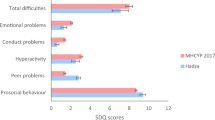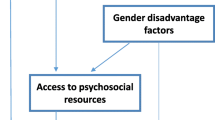Abstract
A severe earthquake occurred in Kashmir in 2005. The epicentre was close to Muzzafarabad. We collected data on over 1,100 children 18 months after the earthquake to look at symptoms of PTSD and behavioural and emotional problems using well established questionnaires. We found that 64.8% of children had significant symptoms of PTSD. Girls were more likely to suffer from these symptoms. The proportion of children suffering from emotional and behaviour difficulties was 34.6%. This percentage was not different from other studies of children from Pakistan within areas which were not affected by the earthquake. The rate of emotional symptoms was higher in girls while hyperactivity was more frequent in boys. This pattern is similar to other studies from across the world.
Similar content being viewed by others
References
Dyregrov A, Yule W (2006) A review of PTSD in children. Child Adolesc Ment Health 11:176–184
Copeland WE, Keeler G, Angold A, Costello EJ (2007) Traumatic events and posttraumatic stress in childhood. Arch Gen Psychiatry 64:577–584
Bromet E, Dew MA (1995) Review of psychiatric epidemiologic research on disasters. Epidemiol Rev 17:113–119
Aptekar L, Boore JA (1990) The emotional effects of disaster on children: a review of the literature. Int J Ment Health 19:77–90
Neria Y, Nandi A, Galea S (2008) Post-traumatic stress disorder following disasters: a systematic review. Psychol Med 38:467–480
Goenjian AK, Pynoos RS, Steinberg AM, Najarian LM, Asarnow JR, Karayan I et al (1995) Psychiatric co morbidity in children after the 1988 earthquake in Armenia. J Am Acad Child Adolesc Psychiatry 34:1174–1184
Shannon MP, Lonigan CJ, Finch AJ Jr, Taylor CM (1994) Children exposed to disaster: I. Epidemiology of post-traumatic symptoms and symptom profiles. J Am Acad Child Adolesc Psychiatry 33:80–93
Vernberg EM, Silverman WK, La Greca AM, Prinstein MJ (1996) Prediction of posttraumatic stress symptoms in children after hurricane Andrew. J Abnorm Psychol 105:237–248
Green BL, Korol M, Grace MC, Vary MG, Leonard AC, Gleser GC et al (1991) Children and disaster: age, gender, and parental effects on PTSD symptoms. J Am Acad Child Adolesc Psychiatry 30:945–951
Lonigan CJ, Shannon MP, Taylor CM, Finch AJ Jr, Sallee FR (1994) Children exposed to disaster: II. Risk factors for the development of post-traumatic symptomatology. J Am Acad Child Adolesc Psychiatry 33:94–105
Pynoos RS, Goenjian A, Tashjian M, Karakashian M, Manjikian R, Manoukian G et al (1993) Post-traumatic stress reactions in children after the 1988 Armenian earthquake. Br J Psychiatry 163:239–247
Goenjian AK, Walling D, Steinberg AM, Karayan I, Najarian LM, Pynoos R (2006) A prospective study of posttraumatic stress and depressive reactions among treated and untreated adolescents 5 years after a catastrophic disaster. Am J Psychiatry 162:2302–2308
Garrison CZ, Weinrich MW, Hardin SB, Weinrich S, Wang L (1993) Post-traumatic stress disorder in adolescents after a hurricane. Am J Epidemiol 138:522–530
Garrison CZ, Bryant ES, Addy CL, Spurrier PG, Freedy JR, Kilpatrick DG (1995) Posttraumatic stress disorder in adolescents after hurricane Andrew. J Am Acad Child Adolesc Psychiatry 34:1193–1201
Kilic EZ, Özguven HD, Sayil I (2003) The psychological effects of parental mental health on children experiencing disaster: The experience of Bolu Earthquake in Turkey. Fam Process 42:485–495
Russoniello CV, Skalko TK, O’Brien K, McGhee SA, Bingham-Alexander D, Beatley J (2002) Childhood posttraumatic stress disorder and efforts to cope after Hurricane Floyd. Behav Med 28:61–71
Lee I, Ha YS, Kim YA, Kwon YH (2004) PTSD symptoms in elementary school children after Typhoon Rusa. Taehan Kanho Hakhoe Chi 34:636–645
Kumar MS, Murhekar MV, Hutin Y, Subramanian T, Ramachandran V, Gupte MD (2007) Prevalence of posttraumatic stress disorder in a coastal fishing village in Tamil Nadu, India, after the December 2004 tsunami. Am J Public Health 97:99–101
McDermott BM, Lee EM, Judd M, Gibbon P (2005) Posttraumatic stress disorder and general psychopathology in children and adolescents following a wildfire disaster. Can J Psychiatry 50:137–143
Green BL, Korol M, Grace MC, Vary MG, Leonard AC, Gleser GC et al (1991) Children and disaster: age, gender, and parental effects on PTSD symptoms. J Am Acad Child Adolesc Psychiatry 30(6):945–951
Kolaitis G, Kotsopoulos J, Tsiantis J, Haritaki S, Rigizou F, Zacharaki L et al (2003) Posttraumatic stress reactions among children following the Athens earthquake of September 1999. Eur Child Adolesc Psychiatry 12:273–280
Asarnow J, Glynn S, Pynoos RS, Nahum J, Guthrie D, Cantwell DP et al (1999) When the earth stops shaking: earthquake sequelae among children diagnosed for pre-earthquake psychopathology. J Am Acad Child Adolesc Psychiatry 38:1016–1023
La Greca AM, Silverman WK, Wasserstein SB (1998) Children’s predisaster functioning as a predictor of posttraumatic stress following Hurricane Andrew. J Consult Clin Psychol 66:883–892
Thienkrua W, Cardozo BL, Chakkraband MLS, Guadamuz TE, Pengjuntr W, Tantipiwatanaskul P et al (2006) Symptoms of posttraumatic stress disorder and depression among children in tsunami-affected areas in southern Thailand. JAMA 296:549–559
La Greca A, Silverman WK, Vernberg EM, Prinstein MJ (1996) Symptoms of posttraumatic stress in children after Hurricane Andrew: a prospective study. J Consult Clin Psychol 64:712–723
Stallard P, Velleman R, Langsford J, Baldwin S (2001) Coping and psychological distress in children involved in road traffic accidents. Br J Clin Psychol 40:197–208
Jones RT, Ribbe DP, Cunningham PB, Weddle JD, Langley AK (2002) Psychological impact of fire disaster on children and their parents. Behav Modif 26:163–186
Ostrowski SA, Christopher NC, Delahanty DL (2007) Brief report: the impact of maternal posttraumatic stress disorder symptoms and child gender on risk for persistent posttraumatic stress disorder symptoms in child trauma victims. J Pediatr Psychol 32:338–342
Wickrama KAS, Kaspar V (2007) Family context of mental health risk in Tsunami-exposed adolescents: findings from a pilot study in Sri Lanka. Soc Sci Med 64:713–723
Laor N, Wolmer L, Kora M, Yucel D, Spirman S, Yazgan Y (2002) Posttraumatic, dissociative and grief symptoms in Turkish children exposed to the 1999 earthquakes. J Nerv Ment Dis 190:824–832
Neuner F, Schauer E, Catani C, Ruf M, Elbert T (2006) Post-tsunami stress: a study of posttraumatic stress disorder in children living in three severely affected regions in Sri Lanka. J Trauma Stress 19:339–347
Najarian LM, Goenjian AK, Pelcovitz D, Mandel F, Najarian B (1996) Relocation after a disaster: posttraumatic stress disorder in Armenia after the earthquake. J Am Acad Child Adolesc Psychiatry 35:374–383
Shaw JA, Applegate B, Schorr C (1996) Twenty-one-month follow-up study of school-age children exposed to Hurricane Andrew. J Am Acad Child Adolesc Psychiatry 35:359–364
Giannopoulou I, Strouthos M, Smith P, Dikaiakou A, Galanopoulou V, Yule W (2006) Post-traumatic stress reactions of children and adolescents exposed to the Athens 1999 earthquake. Eur Psychiatry 21:160–166
Hardin S, Weinrich M, Weinrich S, Hardin T, Garrison C (1994) Psychological distress of adolescents exposed to Hurricane Hugo. J Trauma Stress 7:427–440
Hsu C-C, Chong M-Y, Yang P, Yen C-F (2002) Posttraumatic stress disorder among adolescent earthquake victims in Taiwan. J Am Acad Child Adolesc Psychiatry 41:875–881
Udwin O, Boyle S, Yule W, Bolton D, O’Ryan D (2000) Risk factors for long-term psychological effects of a disaster experienced in adolescence: predictors of post traumatic stress disorder. J Child Psychol Psychiatry 41:969–979
Dyregrov A, Gupta L, Gjestad R, Mukanoheli E (2000) Trauma exposure and psychological reactions to genocide among Rwandan children. J Traum Stress 13:3–21
Ehlers A, Mayou RA, Bryant B (2003) Cognitive predictors of posttraumatic stress disorder in children: results of a prospective longitudinal study. Behav Res Ther 41:1–10
McFarlane AC (1987) The relationship between patterns of family interaction and psychiatric disorder in children. Aust N Z J Psychiatry 21:383–390
Kar N, Bastia BK (2006) Post-traumatic stress disorder, depression and generalised anxiety disorder in adolescents after a natural disaster: a study of comorbidity. Clin Pract Epidemiol Ment Health 2:17
Kar N, Mohapatra P, Nayak K, Pattanaik P, Swain S, Kar H (2007) Post-traumatic stress disorder in children and adolescents one year after a super-cyclone in Orissa, India: exploring cross-cultural validity and vulnerability factors. BMC Psychiatry 7:8
Catani C, Jacob N, Schauer E, Kohila M, Neuner F (2008) Family violence, war, and natural disasters: a study of the effect of extreme stress on children’s mental health in Sri Lanka. BMC Psychiatry 8:33
Breslau N, Davis GC, Andreski P, Peterson E (1991) Traumatic events and posttraumatic stress disorder in an urban population of young adults. Arch Gen Psychiatry 48:216–222
Hubbard J, Realmuto GM, Northwood AK, Masten AS (1995) Comorbidity of psychiatric diagnoses with posttraumatic stress disorder in survivors of childhood trauma. J Am Acad Child Adolesc Psychiatry 34:1167–1173
Sack WH, McSharry S, Clarke GN, Kinney R, Seeley J, Lewinsohn P (1994) The Khmer Adolescent Project. I. Epidemiologic findings in two generations of Cambodian refugees. J Nerv Ment Dis 182:387–395
Naeem F, Ayub M, Masood K, Gul H, Khalid M, Farrukh A et al (2011) Prevalence and psychosocial risk factors of PTSD: 18 months after Kashmir earthquake in Pakistan. J Affect Disord 130:268–274
Ayub M, Irfan M, Nasr T, Lutufullah M, Kingdon D, Naeem F (2009) Psychiatric morbidity and domestic violence: a survey of married women in Lahore. Soc Psychiat Epidemiol 44:953–960
Vostanis P (2006) Strengths and difficulties questionnaire: research and clinical applications. Curr Opin Psychiatry 19:367–372
Samad L, Hollis C, Prince M, Goodman R (2005) Child and adolescent psychopathology in a developing country: testing the validity of the strengths and difficulties questionnaire (Urdu version). Int J Methods Psychiatr Res 14:158–166
Perrin S, Meiser-Stedman R, Smith P (2005) The children’s revised impact of event scale (CRIES): validity as a screening instrument for PTSD. Behav Cogn Psychother 33:487–498
Smith P, Perrin S, Dyregrov A, Yule W (2003) Principal components analysis of the impact of event scale with children in war. Pers Individ Differ 34:315–322
Catani C, Schauer E, Elbert T, Missmahl I, Bette J-P, Neuner F (2009) War trauma, child labor, and family violence: life adversities and PTSD in a sample of school children in Kabul. J Trauma Stress 22:163–171
Panter-Brick C, Eggerman M, Gonzalez V, Safdar S (2009) Violence, suffering, and mental health in Afghanistan: a school-based survey. Lancet 374:807–816
Syed EU, Hussein SA, Mahmud S (2007) Screening for emotional and behavioural problems amongst 5–11-year-old school children in Karachi, Pakistan. Soc Psychiatry Psychiatr Epidemiol 42:421–427
Lassi ZS, Mahmud S, Syed EU, Janjua NZ (2011) Behavioral problems among children living in orphanage facilities of Karachi, Pakistan: comparison of children in an SOS Village with those in conventional orphanages. Soc Psychiatry Psychiatr Epidemiol 46:787–796
Crijnen AA, Achenbach TM, Verhulst FC (1999) Problems reported by parents of children in multiple cultures: the child behavior checklist syndrome constructs. Am J Psychiatry 156:569–574
Author information
Authors and Affiliations
Corresponding author
Rights and permissions
About this article
Cite this article
Ayub, M., Poongan, I., Masood, K. et al. Psychological Morbidity in Children 18 months after Kashmir Earthquake of 2005. Child Psychiatry Hum Dev 43, 323–336 (2012). https://doi.org/10.1007/s10578-011-0267-9
Published:
Issue Date:
DOI: https://doi.org/10.1007/s10578-011-0267-9




